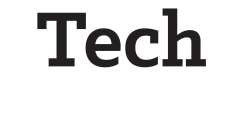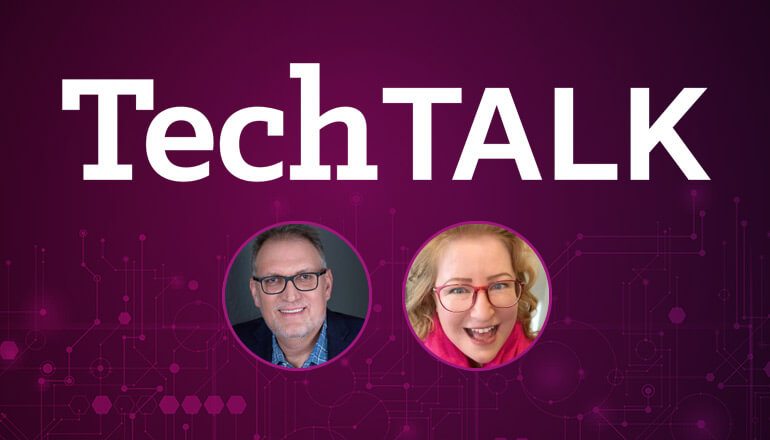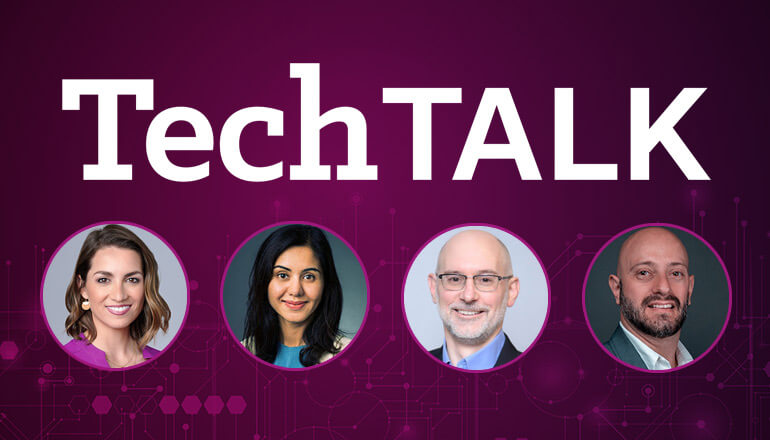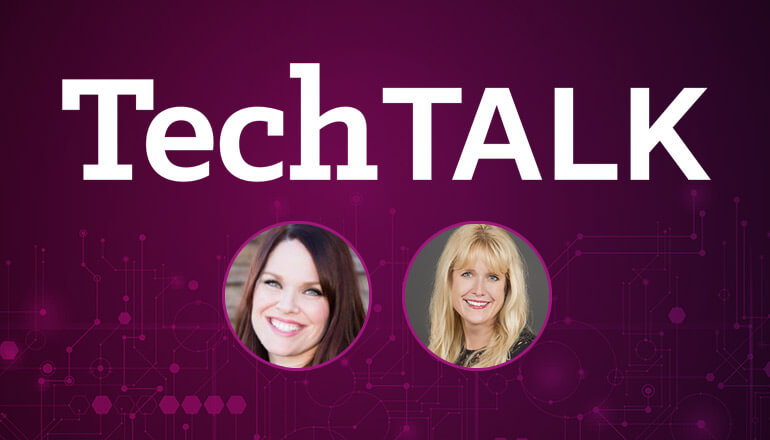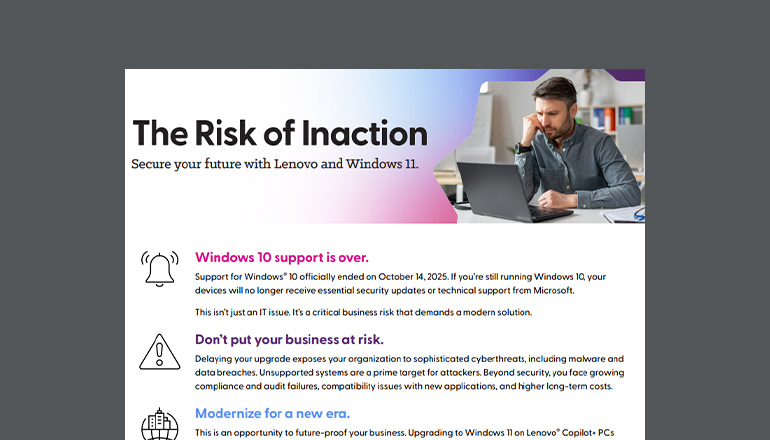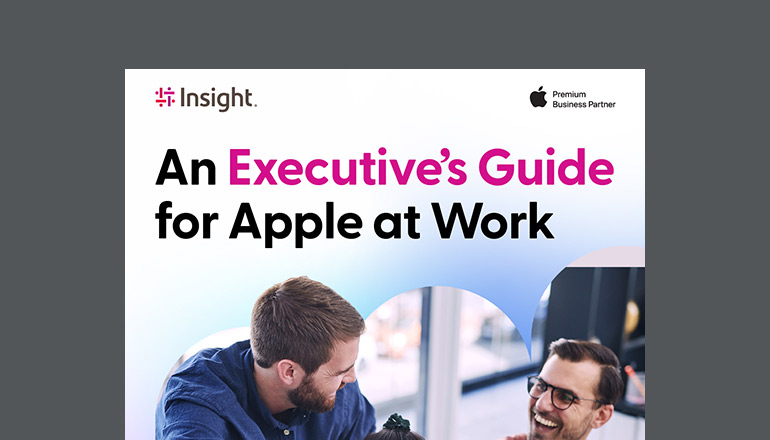Audio transcript:
Organizational Change Management
Published November 13, 2020
MAC
Hello and welcome to Insight Tech Talk. 2020 has caused a major disruption, and the reality is that we're likely facing ongoing uncertainty and change. Organizational change management, or OCM, gives us the framework for dealing with this uncertainty. Think of OCM as the methodology process and tools techniques in order to support successful adoption and sustainment of technology process or culture changes. Essentially, it's the people side of change.
Today, we're going to talk about what we're seeing and hearing related to organizational change out in the field from the eyes of OCM, Agile and technology leaders. My name is Baldeep Mac and I am the national OCM solution lead here at Insight.
I have with me today, Michael Nardone, Senior Manager of Technology Services and Summer Lawrence an Agile Architect, who are also both with Insight. Can you both briefly talk about how exactly changes involved with your respective roles at Insight?
MICHAEL
Yeah, so hey good afternoon Mac and Summer, and hello to all you out there watching, my name is Michael Nardone, as Mac mentioned I'm a Senior Leader at Insight in our cloud enablement and DevOps technology spaces. And what my practice does is we help customers and our clients adapt to change in cloud and DevOps.
So, how do they work their cloud adoption programs, their journey into those new technologies as well as the DevOps aspects side which is how do we actually drive a culture of collaboration to accelerate software delivery and deliver more value to our business.
SUMMER
Hi everyone, I'm Summer Lawrence, one of our Agile architects here at Insight, and I deal with change by the very nature of what I do. Agile is the philosophy of embracing change for competitive advantage. So, a lot of what I do is I help organizations examine the people process and tools changes they need to make at a systems thinking level in order to embrace change constantly and frequently.
MAC
So Michael and Summer, over the last few months, I haven't spoken with a single decision-maker who said that they plan to go back to the same model that they had in 2019 or early 2020, the implications of this trend are significant, and the current situation has actually been a transformation accelerator for a lot of organizations. Virtualization, remote collaboration, automation and even evolution to stay relevant, require new behaviors, new skills, process, roles in technology change, this in turn requires adoption and sustainment.
From your perspective, how do organizations better embrace and adopt change?
MICHAEL
Yeah, so for sure, we certainly see all the same things that you do Mac, but when we think about the tremendous rate of change in technology, think about it the iPhone was introduced in 2007, the cloud technology where my team's live every day, didn't even exist in a public capacity 15 years ago. And so, it's amazing that technology is more accessible than ever. We think about how just this amazing democratization has taken place where end users in their home have access to cognitive services, machine learning, deep learning, big data, AI, bots, remote process automation, all these amazing technologies right? But why do we see certain organizations that not only survived, tremendous, unprecedented circumstances but actually can thrive in an environment that's changing so much, right?
SUMMER
Yeah.
MICHAEL
So, we ask ourselves what is it in their DNA that makes them different, how are they able to thrive regardless of those circumstances that come at them. And so, if we think about it, it's always that, what does that process component and the people component along with the technology that leads to those major innovations and lead forward?
SUMMER
Yeah, I would agree with you Michael, we have a saying we call Larman's Law in Agility, which is culture follows structure. So, what are those structural changes you need to put in chain in place in order to embrace feedback loops? 'Cause I think you asked, Mac, what are companies doing to really embrace change? And as an Agilist, I always recommended that we create staff and support feedback loops in every part of the organization. And when you have a structure that is accepting feedback, welcoming feedback and implementing feedback to promote change, you build a culture that's very flexible to change.
MAC
Yeah, totally agree with that Summer, focusing in on people though, I think we find that organizations sometimes make the mistake of implicitly assuming that, hey, when they roll out this change, the workforce will instantly and collectively make that shift. And in reality, every person moves through the change journey at their own pace. We find that a few people jump onboard right away, but most need support in order to enable adoption, Roger's technology adoption curve is a great visual representation of what we can expect when we make, not only technology changes, but also process changes.
And I like to think about the iPhone as an example, when a new version of the iPhone comes out, you have some people that are standing in line waiting to get that latest version, whereas most people tend to adopt that newest version later in the lifecycle.
Another key I think, is being proactive instead of reactive, we find that when an organization engages experienced OCM support early and they have a well thought out OCM approach, it really does go a long way. And ensuring that approach is based on some upfront assessments, like a change readiness or impact assessment where we can identify gaps, risks, anticipated resistance, who the people are that are impacted, what their communication and training needs along with leadership alignment needs, it really helps to get adoption and sustainment that is expected.
From your perspective, Michael and Summer, how important is being proactive, I just talked about being proactive. How important is that with change?
MICHAEL
Yeah, so I mean, when we think about being proactive, the highest performing teams right, the leaders from that technology perspective, they're always intentional about the growth, the learning, the development of their teams. Again, they have a culture which puts their precedent on the ability to learn and adapt and grow. But the thing you see is, although they have some very flexible structures to adapt to change, they're also, again very intentional in that growth of their organizations they have change champions. They even have entire sections of their teams that are devoted just to how to better adopt and onboard change into their teams.
SUMMER
Yeah, and from the Agile perspective, a lot of what we do when we talk about process coaching is how do you bake the cost of change? That includes risk, that includes the financial impact and the change impact on your people into your everyday activities. So for us, we like to go a step beyond proactive and say how do we normalize change as a part of this organization, and then optimize on the change that's being sent to the organization for our market advantage. So, the way we work, we try to embrace it and normalize it.
MICHAEL
And I think that's a great point Summer, Peter Drucker, the father of modern management he said, "culture eats strategy for breakfast” and having that change ready culture can make all the difference.
SUMMER
Right, and you don't get to the culture unless you put the structure in place. And there's a lot of nuts and bolts to building a change, embracing culture. And if you take a systems thinking view and you do look at the people part, you do look at the process part and you look at the tools part, you can make some wise decisions about how to pull your risk left and bring change in and make it valuable.
MAC
Yeah, I love the context of thinking of change from the perspective of people process and tools. One thing that we're seeing is change fatigue and change saturation, I'd like to talk about that for a moment.
The reality is that, most if not all organizations are executing multiple change initiatives that are impacting the same people at the same time. Obviously this causes a major risk of change saturation and fatigue, even when the people that are typically the most willing to embrace changes. Change saturation is a state where the amount of change exceeds the organization's capacity to adopt, and what happens is chaos and turmoil become the norm, and it makes change initiatives very difficult to succeed. Change fatigue refers to a sense where personal and professional exhaustion is felt by a person because of excessive change happening. How do you address this?
What are your thoughts Michael and Summer on that?
SUMMER
Yeah, and this was addressed very early on in part of developing the Agile manifesto because agility drives change and that absorbs change where a constant cycle of change, for market advantage. And we have a principle of sustainability, always working at a sustainable pace. And that goes back to the concept of baking all the costs of change including people exhaustion into your rate of delivery. That even goes to baking the effects of change into forecasting in release, to give very specific examples of what embracing change does to timelines. Exhaustion is a very real thing, and it was recognized early and it's got to be part of a plan.
MICHAEL
Yeah, and I think Summer really touched on it well, you have to be extremely mindful of the impacts that your change is going to have on your people. And again, the leaders that we see that they're mindful of that, but they're also very collaborative and bring in the right ways to make that learning fun to develop their people and change isn’t as scary when you equip your people with the right technical skills and the right tools to arm them for change.
MAC
Yeah, I was just thinking back about both of you mentioned change culture, and I think that building a change capable culture really helps to mitigate the risk of change saturation fatigue, because they're used to it right, we get them accustomed to it. And one of the ways we start this is by building enterprise level change capability within the organization. So, the goal is essentially to build a culture of resilience of agility and understanding that, hey small reoccurring changes, that's the new norm. That means embedding the tools and techniques to understand prioritize and manage change into the business strategy really at the highest level. We're seeing an increase of organizations in the OCM world better standing up change management offices or CMOs and they help to measure and improved change management capability. In 20 years of benchmark data from ProSight tells us that companies with the CMO in place, rank higher on the maturity curve, meaning they're able to better adapt to change.
Summer and Michael, have you guys had any experience with CMOs? What, what's been that experience if you have?
MICHAEL
Yeah, from my experience, we talked specifically about being able to adopt cloud technologies, being able to be on the cutting edge. Office of the CMO when we see that in place, we know the likelihood of success is so much greater. One of the things we look at is 50% of the Fortune 500 is not going to be on the Fortune 500 in 10 years. And your ability to adopt change and put the right structures in place, is going to directly influence your ability and to be on which side of that equation.
SUMMER
Yeah, I don't often hear the term CMO, I hear it occasionally, but I do often advocate for the roles that are needed in any kind of transformation whether it be digital, whether it be DevOps, whether it be Agile process transformation to own and champion change. And when we get buy-in and people taking responsibility for the change, the feedback loop and the impact on the organization, adoption is accelerated. It's tremendously accelerated. And we get to value a lot sooner. And that's what it's all about for Agilists, let's get to value early so we can decide what we want to do next.
MAC
Sure yeah. I'll tell you, I'm having a CMO really standardizes OCM, we found that it allows the right people to stay focused on the right changes. And the CMO also can take a portfolio view of all the change initiatives that are coming down the pipe to understand who's on the receiving end of multiple changes at once. It also allows for prioritization and more effective communications by bundling those communications.
Michael and Summer, do you have any final bits of advice before we wrap this up today?
MICHAEL
Yeah, I would say you're either disrupting your industry or you're being disruptive. So, your ability to manage change directly influences which side you're up.
SUMMER
Yeah, and I would definitely plus one, Michael statement, most organizations out there are doing complex work and either how you do the work changes quickly or what people want changes quickly. Recognizing and accepting that and making it part of what you do every day is to your advantage.
MAC
Yeah, all right. Well, thank you for your insights today Michael and Summer. To learn more about effective organizational change management, we encourage you to check out the Fall issue of Insights' digital magazine, the Tech Journal, read and subscribe at Insight.com/techjournal.
[Music]
